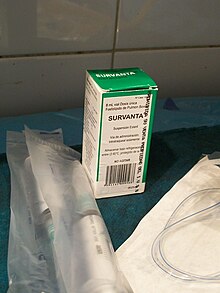Pulmonary surfactant (medication)
 Beractant, surrounded by devices for its application. | |
| Clinical data | |
|---|---|
| Pronunciation | Curosurf, Survanta, others |
| Other names | Beractant, Poractant alfa, others |
| AHFS/Drugs.com | Monograph |
| License data | |
| ATC code | |
| Identifiers | |
| CAS Number |
|
| ChemSpider |
|
Pulmonary surfactant is used as a medication to treat and prevent respiratory distress syndrome in newborn babies.[1]
Prevention is generally done in babies born at a gestational age of less than 32 weeks.[1] It is given by the endotracheal tube.[1] Onset of effects is rapid.[2] A number of doses may be needed.[2]
Side effects may include slow heart rate and low oxygen levels.[1] Its use is also linked with intracranial bleeding.[1] Pulmonary surfactant may be isolated from the lungs of cows or pigs or made artificially.[1][3][4]
Pulmonary surfactant was discovered in the 1950s and a manufactured version was approved for medical use in the United States in 1990.[3] It is on the World Health Organization's List of Essential Medicines.[5]
Medical uses[]
Pulmonary surfactant is used to treat and prevent respiratory distress syndrome in newborn babies.[1] Prevention is generally done in babies born less than 32 weeks gestational age.[1] Tentative evidence supports use in drowning.[6]
Types[]
There are a number of types of pulmonary surfactants available. Like their natural counterparts, pulmonary surfactant preparations consist of phospholipids (mainly DPPC) combined with spreading agents such as SP-B and SP-C.[7]
Synthetic pulmonary surfactants:
- Colfosceril palmitate (Exosurf) - a mixture of DPPC with hexadecanol and tyloxapol added as spreading agents
- Pumactant (Artificial Lung Expanding Compound or ALEC) - a mixture of DPPC and PG
- Lucinactant (KL-4) - composed of DPPC, palmitoyl-oleoyl phosphatidylglycerol, and palmitic acid, combined with a 21 amino acid synthetic peptide () that mimics the C-terminal helical domain of SP-B.[8]
- Venticute - DPPC, PG, palmitic acid and recombinant SP-C
- Lucinactant (trade name Surfaxin) is a liquid medication that contains DPPC, as the sodium salt, and palmitic acid.
Animal derived surfactants:
- Beractant
- (Alveofact) - extracted from cow lung lavage fluid, manufacturing by Boehringer Ingelheim
- (Survanta) - extracted from minced cow lung with additional DPPC, palmitic acid and tripalmitin, manufacturing by Abbvie
- (Beraksurf) - extracted from minced cow lung with additional DPPC, palmitic acid and tripalmitin, manufacturing by
- Calfactant (Infasurf) - extracted from calf lung lavage fluid
- Poractant alfa (Curosurf) - extracted from material derived from minced pig lung
History[]
Researcher John Clements identified surfactants and their role in the 1950s. Mary Ellen Avery soon after showed that the lungs of premature infants couldn't produce surfactants.[9]
Exosurf, Curosurf, Infasurf, and Survanta were the initial surfactants FDA approved for use in the U.S.[10]
In 2012, the US FDA approved an additional synthetic surfactant, lucinactant (Surfaxin).[citation needed]
References[]
- ^ Jump up to: a b c d e f g h British national formulary : BNF 69 (69 ed.). British Medical Association. 2015. p. 217. ISBN 9780857111562.
- ^ Jump up to: a b Fanaroff, Avroy A.; Fanaroff, Jonathan M. (2013). Klaus and Fanaroff's Care of the High-Risk Neonate, Expert Consult - Online and Print,6: Klaus and Fanaroff's Care of the High-Risk Neonate. Elsevier Health Sciences. p. 252. ISBN 978-1416040019. Archived from the original on 2017-01-09.
- ^ Jump up to: a b Lantos, John D.; Meadow, William L. (2006). Neonatal Bioethics: The Moral Challenges of Medical Innovation. JHU Press. pp. 54–56. ISBN 9780801883446. Archived from the original on 2017-01-09.
- ^ Slonim, Anthony D.; Pollack, Murray M. (2006). Pediatric Critical Care Medicine. Lippincott Williams & Wilkins. pp. 724–725. ISBN 9780781794695. Archived from the original on 2017-01-09.
- ^ World Health Organization (2019). World Health Organization model list of essential medicines: 21st list 2019. Geneva: World Health Organization. hdl:10665/325771. WHO/MVP/EMP/IAU/2019.06. License: CC BY-NC-SA 3.0 IGO.
- ^ Brady, Bill; Charlton, Nathan P.; Lawner, Benjamin J.; Sutherland, Sara F. (2012). Cardiac Arrest, An Issue of Emergency Medicine Clinics. Elsevier Health Sciences. p. 175. ISBN 978-1455742769. Archived from the original on 2017-01-09.
- ^ Nkadi, Paul O.; Merritt, T. Allen; Pillers, De-Ann M. (2009). "An overview of pulmonary surfactant in the neonate: Genetics, metabolism, and the role of surfactant in health and disease". Molecular Genetics and Metabolism. 97 (2): 95–101. doi:10.1016/j.ymgme.2009.01.015. ISSN 1096-7192. PMC 2880575. PMID 19299177.
- ^ "KL4 Surfactant Technology - Windtree Therapeutics, Inc". Windtree Therapeutics, Inc. Archived from the original on July 29, 2018. Retrieved 29 November 2017.
- ^ Palca, Joe (3 August 2015). "How A Scientist's Slick Discovery Helped Save Preemies' Lives". NPR. Archived from the original on 3 August 2015. Retrieved 3 August 2015.
- ^ Taeusch, H William; Lu, Karen; Ramierez-Schrempp, Daniela (2002). "Improving pulmonary surfactants" (PDF). Acta Pharmacologica Sinica. 23 Suppl: 11–5. Archived (PDF) from the original on 2015-03-01.
External links[]
- "Poractant alfa". Drug Information Portal. U.S. National Library of Medicine.
- "Beractant". Drug Information Portal. U.S. National Library of Medicine.
- "Calfactant". Drug Information Portal. U.S. National Library of Medicine.
- World Health Organization essential medicines